
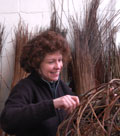
The
Scottish basket-maker, Lizzie Farey, produces exquisitely turned and elemental
wood weavings
relating a world of nature, which seems to sit between some perfectly finished natural process and the
intricate guidance of the human maker. Her various spherical willow nests, and on occasion other forms, emanate an exterior of calm presence intertwined with inner spaces filled with action and movement.
relating a world of nature, which seems to sit between some perfectly finished natural process and the
intricate guidance of the human maker. Her various spherical willow nests, and on occasion other forms, emanate an exterior of calm presence intertwined with inner spaces filled with action and movement.
It
is almost as if a dry wind has blown along an autumn
lane, picked up loose fragments of hedgerow life and rolled the willow balls into being, depositing each to
be found and smoothed by human agency. She is,
she says, "...working from the inside out. They start
in chaos and work towards stillness. That dynamic quality nourishes me while I am working. A friend describes the balls as 'moving in stillness'."
lane, picked up loose fragments of hedgerow life and rolled the willow balls into being, depositing each to
be found and smoothed by human agency. She is,
she says, "...working from the inside out. They start
in chaos and work towards stillness. That dynamic quality nourishes me while I am working. A friend describes the balls as 'moving in stillness'."
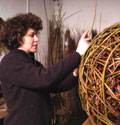
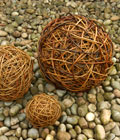
Along
with willow, Farey uses many other woods, often from hedgerows; hazel,
birch, ash, dogwood, larch or briar rose. Some are spherically self-contained
balls, whilst others continue outwards; branches dancing
with their seed-heads intact. Farey's immersion in wood, and specifically willow, emerged after a period of working with stained glass in the early nineties. She had begun to find "the medium of glass too brittle and sharp and the soldering of lead too polluting".
with their seed-heads intact. Farey's immersion in wood, and specifically willow, emerged after a period of working with stained glass in the early nineties. She had begun to find "the medium of glass too brittle and sharp and the soldering of lead too polluting".
She
visited her sister-in-law in North Wales for a weekend, who was also basket-making,
and returned with two baskets she'd made herself. Excited, she bought
two bolts of willow and continued. "I found such a contrast with the glass
- the yielding, flexibility of the willow, the woody smell - almost like
incense - and the natural colours were a delight and led me on to work
for hours and hours, developing a relationship with the wood. Things began
to flow in a way that I had never experienced with the glass." She moved
to an isolated house in an area of hills, with larch, spruce woodland,
planted willows and dogwood in the garden.
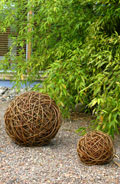
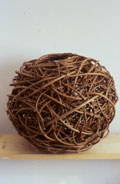
"The
grace and beauty of the willows matched the surrounding landscape. It
made sense to me to be using and working with a material that was natural
to my surroundings. I used to spend hours walking and exploring the woods
and hills and this led me to start weaving with materials other than willow,
such as heather, bog myrtle, field rush and wild raspberry, that grew
nearby. Apart from willow I've found that by working with and watching
the larch tree grow, l've begun to form connections with it. The larch
is a very slender tree and very dancey indeed. Watching the new growth
in spring is so delightful."
"I can weave the knobbly new twigs into bowl shaped baskets. Recently
I've found similar connections with aspen, which is also tall and slender.
There's a tremulous quality to it that I relate to." Farey's sculptural
nests may appear a significant remove from traditional basketry, but look
at their bases and those age-old traditions are clearly visible at the
core. In this sense, her work sits within a wider local Scottish tradition
of basketry. She also makes traditional baskets, fruit and bread baskets,
creels and log baskets using traditional weaves with home-grown willow.
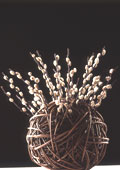
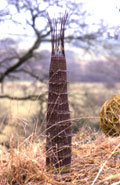
The
willow balls and other forms sit in and explore the space between land
and nature art and its older relation, the basket-maker's craft. Farey's
work can be seen, alongside other, often female, Scottish-based wood weavers
- Lise Bech, Valerie Pragnell and Sally MacIntosh, for instance - as extending
the craft of basketry into the realm of nature art. It is a new tradition
touched by the remaining wildness of the Scottish landscape. "There is
a close connection to natural materials here. It may be the Celtic experience,
but there is a natural ease of relationship between basket-makers and
their landscape and its plants."
To an extent there is a 'tension' between basket-making's original functional
realm and remit as carrier and container and its contemporary flight towards
abstraction. An interesting middle-ground is occupied by those working
alongside the holism of the land and nature art. Farey is an admirer of
both Chris Drury and David Drew, as well as in basketry, the Japanese
Hisako Sekijama. Each path connects with the year's round, and with its
archaic past of the rituals of the passing of the seasons. "There is a
connection developing between the new forms of basket-making as aesthetic
expression and land and nature art. Both are products of a changing world.
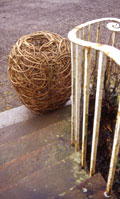
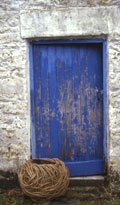
Nature
art firmly roots you in the here and now, and has an arresting quality
that the creative process of basket-making also has. I would like to see
more of a crossover between one and the other; some of the age-old techniques
could be useful to the nature artist. I wish we could come together more.
It may all fizzle out. It would be nice to bring the two relationships
together, share the weaves which each group knows separately, and bridge
a part of the gap between the two. A nature artist, Stuart Frost, came
to one of my traditional basket courses and seemed quite threatened, especially
at first, although in the end he opened up. It seems like never the twain..."
There
is a sense in which both land art and these new departures for basketry
are pushing at the boundaries of traditional technique, making a new third
space. Its position is confused as it is both and neither craft, nor as
it is usually described, exactly an art form. Similarly, you might ask
whether the process of the making of a form, or the end object itself,
is craft or artwork? Or again both. Farey acknowledges this: "Its such
a fine line. These days, we like to say we're artists, but it's different
- we're not relying on the old forms", she states at first, before later
talking about how weaves which continue to be passed on after thousands
of years across cultures ensure the survival of the traditional basket
form.
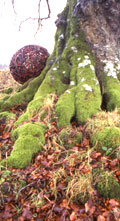
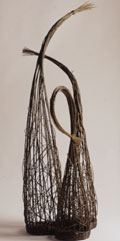
"However, with the new ecological consciousness, and with new basketry
materials and many exchanges of old techniques across continents, basket-making
is growing beyond its traditional roots towards new art forms. Makers
are stimulated to an unprecedented degree as never before. It's very exciting.
The link between art and craft is the beauty and richness of the natural
realities they both use." Farey's work also connects to, and collects
from, the secret life of hedgerows; these ancient, small and mostly unnoticed
treasure troves in the midst of the British landscape, still vulnerable
to being extinguished by farming and urbanisation. "Hedgerows created
as functional, fertile boundaries become something else as seeds and plants
are blown in, take root there and provide shelter for animals, birds and
insects.
They are woven forms in a random weave and are containers of the countryside.
When they are cut, they regenerate year after year. I connect witn hedgerows
as I harvest the materials for my baskets. Farey runs classes across Scotland,
encompassing hedgerow basket-making and random weave techniques. When
asked if she senses people beginning with basketry emerging into a kind
of awakening of knowledge, hitherto dormant, the fingers remembering,
as other basketmakers have said, she offers a slightly different perspective.
"I don't think it is such a conscious act as that. In basket-making classes
you often reach a stage when a whole class becomes quiet and meditative,
and a rhythmical present moment takes over."
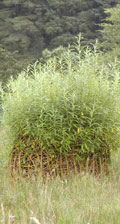
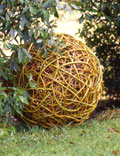
The traditions of basketry, an ignored and lost practice to many, remain
in the quiet lanes of craft, though perhaps in better health than an outsider
would think. "It will always come back to the basket", she says of her
craft. Yet for Farey and weavers like her, whilst still rooted in the
archaic practice of the weave, its marriage to the sculptural is an exhilarating
freedom, an opportunity to explore wholly undiscovered forms and a new
relation to nature.